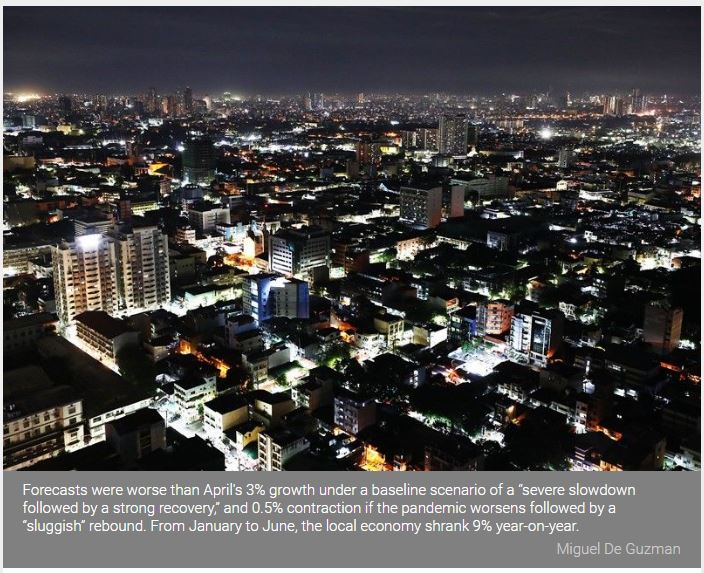World Bank sees 2 million more poor Filipinos from pandemic
MANILA, Philippines (UPDATE 1 1:06 p.m., Sept. 29) — Around 2 million Filipinos would slide back to poverty this year because of the pandemic, nearly erasing gains over the past 5 years and making a rebound to pre-pandemic growth a struggle for the Philippines.
The poverty rate could rise to 20.5% this year and 22.4% next year from the official 16.7% in 2018, the World Bank said on Tuesday. “The ‘new poor’ are those who were unable to work during the pandemic,” Rong Qian, senior economist, said in a briefing.
While the government only measures poverty every 3 years, with the next one scheduled for next year, World Bank’s assumptions show a great undoing of a years worth of gains in fighting poverty. At the projected 2021 level, poverty would nearly go down to its 2015 level of 23.5%.
That said, the Duterte administration itself has been resigned to more Filpinos getting poor next year despite massive social interventions. The expected poverty rate, however, is smaller than that of World Bank at15.5% to 17.5%.
“If wage and non-farm employment increase with GDP growth and inflation is stable, the poverty rate will likely decline back to its 2018 level by 2021 and maintain a downward trend through 2022,” Qian said.
More people becoming poor is a potential consequence of a bleaker economic outlook. In an update to its economic forecasts, the Washington-based lender now see the local economy either shrinking 6.9% year-on-year under a “baseline scenario” or by a bigger 9.9% under a “low-case scenario.”
Forecasts were worse than April’s 3% growth under a baseline scenario of a “severe slowdown followed by a strong recovery,” and 0.5% contraction if the pandemic worsens followed by a “sluggish” rebound. From January to June, the local economy shrank 9% year-on-year.
“The COVID-19 shock is now abruptly pushing the economy into recession and threatening these economic and social gains,” the multilateral lender said.
Slower rebound
A rebound next year has also become a difficult climb. On a baseline, the World Bank sees the Philippine economy growing 5.3% year-on-year in 2021 or 2.9% if the health crisis drags on. Latest projections were down from April’s 6.2% and 4.1%, respectively.
The Duterte administration sees the economy sinking 5.5% this year before rebounding to 6.5% growth in 2021.
The World Bank said cash transfers to poor families, while were helpful during the height of lockdowns from March to June, were likewise hampered by inadequate infrastructure that made it a struggle to reach target beneficiaries.
“In the short-term, every peso put directly in the hands of poor and vulnerable families through social assistance translates into demand for basic goods and services in local communities which in turn supports micro and small enterprises…,” Ndiamé Diop, country director, said in a statement.
Indonesia, Philippines struggle
Over the long-term, Qian, the agency’s senior economist, said the Duterte administration’s decision to prioritize infrastructure spending to recover can provide sustainable support to growth.
But on the ground, the lender also noted the need to directly support the poor and informal sectors, one that has greatly increased the risk of coronavirus contagion given their overly congested residences.
Lockdowns, the World Bank said, have so far been ineffective in arresting the spread of infections.
Across East Asia, the same scenario can be found in Indonesia, where Southeast Asia’s largest population that previously worked on its favor to support growth, has hampered virus containment efforts. But Philippines is seen more vulnerable than Jakarta to economic shocks coming from lower tourism receipts, dismal trade and weaker remittances from residents abroad.
“Indonesia’s output is therefore projected to be less affected than that of the Philippines, but the outlook is uncertain… (They) face the prospect of an uneven and volatile economic recovery,” the report said. Indonesia is seen shrinking 1.6% and 2% year-on-year under a baseline and worst scenarios, respectively.
On average Southeast Asia, as a region, is forecast to contract 3.5% annually under a baseline scenario, a turnaround from April’s 1.3% growth forecast. Broken down, only Thailand, which is seen to slump 8.3% on-year, is poised to contract deeper than the Philippines this year. Myanmar (0.5%) and Vietnam (2.8%) are projected to post growth in 2020.
In a separate briefing, Rosemarie Edillon, deputy director-general at the National Economic and Development Authority, said the economy likely persisted on weakening last quarter. “We are hoping that it will be better than the second quarter but we don’t think it will be positive on a year-on-year (basis),” she said.
Source: https://www.philstar.com/business/2020/09/29/2045941/world-bank-sees-2-million-more-poor-filipinos-pandemic


 Thailand
Thailand




